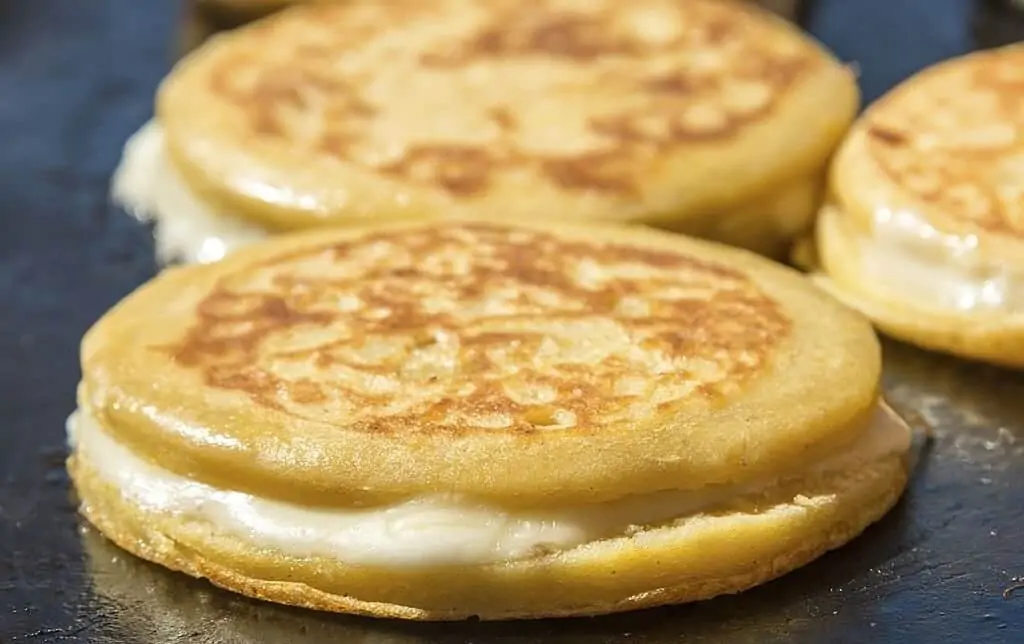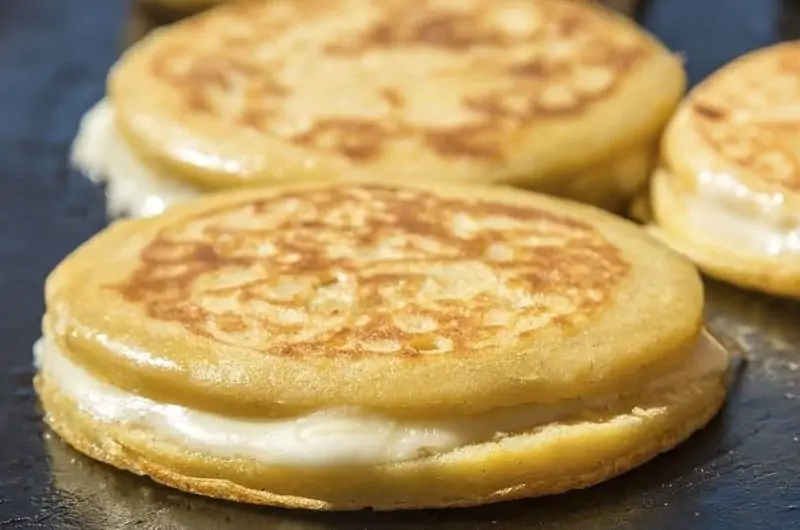The Best Fluffy Pancakes recipe you will fall in love with. Full of tips and tricks to help you make the best pancakes.
In the vibrant tapestry of Colombian cuisine, the “Arepa Colombiana” stands out as a culinary gem. This savory treat, deeply rooted in the country’s culture, has captured the hearts and taste buds of locals and travelers alike. From its humble beginnings to its widespread popularity, let’s embark on a journey to discover the rich history, diverse variations, and the art of crafting the perfect Arepa Colombiana.
The heart and soul of Colombian cuisine, the Arepa Colombiana, is more than just a dish—it’s a cultural emblem. With a history dating back centuries, it has evolved from a simple corn cake to a beloved national treasure. This circular, thick, and hearty cornbread has found its way into every Colombian household, gracing breakfast tables, lunch spreads, and dinner feasts. Its versatile nature allows it to pair seamlessly with various accompaniments, making it an integral part of Colombian meals.
Arepa Colombiana: A Delectable Culinary Journey

Table of Contents
What is Arepa Colombiana
Arepa Colombiana stands as a testament to the artistry of Colombian cuisine, weaving together tradition, flavor, and cultural significance into a single delectable creation. The term “Arepa” refers to a flat, round cake made primarily from cornmeal. These cakes are a staple in various Latin American countries, but in Colombia, they take on a unique identity, reflecting the country’s diverse geography and culinary practices. This iconic dish encapsulates the essence of Colombian culinary heritage and has garnered admiration both within the country and beyond its borders.
Origins
Arepa Colombiana, a culinary masterpiece that encapsulates the essence of Colombian culture, has a history as rich and diverse as the country itself. This beloved dish has undergone a transformative journey from its humble beginnings to becoming a symbol of Colombian gastronomy. Let’s embark on a historical exploration of the origins of Arepa Colombiana and trace its evolution up to the present day.
- Ancient Beginnings: The origins of Arepa Colombiana can be traced back to the indigenous peoples of Colombia, who cultivated and consumed maize as a dietary staple. Maize, or corn, was not only a vital source of sustenance but also held cultural significance in their communities. These resourceful indigenous cooks would grind maize into flour and then mix it with water and salt to create a simple dough, which they would shape into flat discs. These discs were then cooked over open flames, eventually giving birth to the very first iterations of arepas.
- Colonial Influence: The arrival of Spanish colonizers in Colombia brought about a significant transformation in the way arepas were prepared and enjoyed. The introduction of wheat flour from Europe led to the evolution of the traditional corn-based recipe. The use of wheat flour not only altered the texture of the arepas but also allowed for creative adaptations. During this period, arepas became a staple food not only for indigenous populations but for all Colombians. They were no longer limited to basic shapes; rather, they were crafted into various sizes and thicknesses, each catering to different tastes and preferences.
- Arepa Today: In contemporary Colombia, Arepa Colombiana holds a special place in the hearts of Colombians and visitors alike. It has evolved from a basic sustenance food to a symbol of national pride and culinary creativity. Today, arepas are not only enjoyed as traditional street food but also find their way onto gourmet restaurant menus, often adorned with innovative and gourmet toppings.
The journey of Arepa Colombiana is a testament to the intricate interplay between history, culture, and gastronomy. From its humble beginnings in indigenous kitchens to its contemporary status as a beloved national dish, the arepa’s evolution has been a reflection of Colombia’s diverse heritage. As you indulge in the savory delights of Arepa Colombiana, you’re not just savoring a dish—you’re savoring centuries of history and culinary artistry that have stood the test of time.
Popularity of Arepa Colombiana in Other Countries
Arepa Colombiana, with its irresistible blend of textures and flavors, has transcended borders to become a global culinary sensation. While rooted in Colombian culture, this cornmeal delight has found its way onto plates around the world. Here are some countries where Arepa Colombiana has won over the hearts of food enthusiasts and carved out its place in international cuisine.
- United States: With a significant Colombian diaspora, the United States has become a hub for Arepa Colombiana enthusiasts. Colombian restaurants and food trucks dot cities like Miami, New York, and Los Angeles, offering authentic Arepa Colombiana experiences. Food festivals and cultural events celebrate this beloved dish, introducing it to a wider audience.
- Venezuela: While Arepa Colombiana and Venezuelan arepas share similarities, they also have distinct characteristics. In Venezuela, arepas are a staple food, enjoyed in various forms with a wide array of fillings. The cross-border culinary exchange has led to an appreciation for both versions, with each country’s arepa finding its place in the hearts of locals and visitors alike.
- Spain: Spanning across the Atlantic, Arepa Colombiana has made its mark on Spanish cuisine. Colombian expatriates have brought their culinary heritage with them, establishing eateries that serve traditional Colombian fare, including the cherished arepas. As a result, Spain offers a taste of Colombian flavors, delighting both Colombians living abroad and curious locals.
- Australia: Even down under, Arepa Colombiana has garnered attention among food enthusiasts. Colombian expats and curious Australians have embraced this dish, creating a demand for Colombian cuisine in various cities. From Sydney to Melbourne, Colombian restaurants offer a slice of home through authentic arepas.
- Canada: In Canada’s diverse culinary landscape, Arepa Colombiana has carved out its own niche. Colombian communities in cities like Toronto and Vancouver have introduced this dish to local food scenes, sharing its delicious appeal with Canadians from all walks of life.
- Other Countries: Beyond these highlighted nations, Arepa Colombiana has gained recognition in countries across the globe. From Mexico to Chile, and from the United Kingdom to Italy, the appeal of this iconic Colombian dish continues to grow.
Arepa Colombiana’s journey is one of culinary exploration, cultural exchange, and universal delight. From the streets of Colombia to tables around the world, this cornmeal creation has found a place in the hearts and palates of food enthusiasts everywhere. So, whether you’re savoring Arepa Colombiana in a vibrant Colombian market or relishing it in a faraway land, you’re experiencing a dish that has made its mark as a global gastronomic delight.
Variations of Arepa Colombiana
Arepa Colombiana, a culinary gem loved by Colombians and food enthusiasts worldwide, has inspired a myriad of variations that celebrate both tradition and innovation. These variations showcase the creativity of Colombian cooks and the flexibility of the arepa’s basic ingredients. In this section, we’ll embark on a gastronomic journey, exploring the diverse and mouthwatering variations of Arepa Colombiana.
- Arepa de Choclo: Arepa de Choclo is a variation that introduces a touch of sweetness to the classic arepa. Made with fresh corn, this variation results in a slightly sweet and tender arepa. The fresh corn kernels add bursts of flavor and texture, while melted cheese in the center offers a delightful contrast. Arepa de Choclo embodies the harmony between savory and sweet, making it a beloved treat across Colombia.
- Arepa de Huevo: Arepa de Huevo is a tantalizing variation that takes the indulgence factor up a notch. A whole egg is cracked directly into the center of the arepa dough before frying. The result is a crispy exterior encapsulating a runny and flavorful egg yolk. This variation offers a delightful interplay of textures and tastes, making it a favorite for breakfast or as a satisfying snack.
- Arepa Paisa: Arepa Paisa is a heartier variation that hails from the Antioquia region. Larger and thicker than other arepas, Arepa Paisa is often enjoyed as a substantial meal. It’s accompanied by traditional Colombian ingredients like hogao (a flavorful sauce made with tomatoes and onions), beans, and chorizo. The result is a satisfying and savory combination that celebrates the bold flavors of Colombia.
- Arepa Rellena: Arepa Rellena offers a canvas for culinary creativity, allowing cooks to stuff the arepa with an array of fillings. From gooey melted cheese to savory shredded meats and crisp vegetables, this variation caters to individual tastes and preferences. Arepa Rellena is a delicious manifestation of versatility, making each bite a surprise of flavors and textures.
- Arepa con Queso: Arepa con Queso celebrates the universal love for cheese. This variation features a generous amount of cheese mixed into the arepa dough, creating a savory and gooey interior. The cheese becomes beautifully melted and golden-brown during the cooking process, enveloping the arepa in irresistible cheesiness. Arepa con Queso is a favorite among cheese aficionados.
- Arepa Moderna: Arepa Moderna embraces contemporary culinary trends, introducing gourmet ingredients and modern fillings to the classic arepa. From avocado slices and smoked salmon to gourmet spreads, this variation showcases the arepa’s adaptability to evolving tastes. Arepa Moderna adds a touch of sophistication to a beloved tradition.
The variations of Arepa Colombiana serve as a testament to the dynamic nature of Colombian cuisine. From the sweet surprise of Arepa de Choclo to the bolder flavors of Arepa Paisa, each variation offers a unique journey of flavors and textures. Whether honoring tradition or embracing innovation, Arepa Colombiana variations continue to captivate taste buds and celebrate the essence of Colombian culinary creativity.
Is Arepa Colombiana un-healthy?
While Arepa Colombiana is celebrated for its exquisite taste and cultural significance, it’s also worth exploring the array of health benefits that this cornmeal creation brings to the table. From its nutritious ingredients to its dietary versatility, Arepa Colombiana offers more than just a delicious culinary experience. Let’s unravel the nutritional goodness of Arepa Colombiana and shed light on the positive impact it can have on your well-being.
A Source of Sustenance
- Cornmeal: The primary ingredient in Arepa Colombiana is cornmeal, which is a complex carbohydrate. Complex carbs provide sustained energy, making arepas a filling option that keeps you fueled throughout the day.
- Fiber Content: Arepas made from whole-grain cornmeal are rich in dietary fiber. Fiber supports digestive health, helps maintain healthy cholesterol levels, and contributes to a feeling of fullness, aiding in weight management.
Nutrient-Rich Fillings
- Protein: Arepas can be stuffed with a variety of fillings, some of which are excellent sources of protein. Ingredients like shredded meats, cheese, and beans contribute to your daily protein intake, which is essential for muscle repair and overall bodily function.
- Vitamins and Minerals: Depending on the fillings, Arepa Colombiana can introduce a range of vitamins and minerals to your diet. For instance, avocado provides heart-healthy monounsaturated fats and vitamins like potassium and vitamin E. Cheese offers a dose of calcium for strong bones.
Dietary Adaptability
- Gluten-Free Option: Arepa Colombiana made from cornmeal is naturally gluten-free, making it an excellent choice for individuals with gluten sensitivities or celiac disease.
- Customizable Nutrition: The beauty of Arepa Colombiana lies in its versatility. You can tailor the fillings to your dietary preferences and needs, ensuring that you’re getting the nutrients your body requires.
Savoring Tradition with a Nutritional Twist
- Moderation: While Arepa Colombiana boasts numerous health benefits, it’s important to enjoy it in moderation. Pay attention to portion sizes and balance your diet with a variety of nutrient-rich foods.
- Cultural and Social Connection: Beyond its nutritional value, Arepa Colombiana fosters a sense of connection with Colombian culture and traditions. Sharing this dish with loved ones and experiencing the joy of communal meals can contribute to overall well-being.
Arepa Colombiana not only tantalizes your taste buds but also offers a range of health benefits that can positively impact your well-being. From its fiber-rich cornmeal base to its nutrient-packed fillings, Arepa Colombiana showcases the harmony between flavor and nutrition. Whether you’re seeking sustained energy, essential nutrients, or a gluten-free option, this beloved dish delivers on multiple fronts. So, the next time you savor a warm and crispy Arepa Colombiana, know that you’re not just treating yourself to a culinary delight—you’re also nourishing your body with a nutritious and flavorful experience.
How to Make Arepa Colombiana
Arepa Colombiana, a cherished icon of Colombian cuisine, is a dish that encapsulates tradition, flavor, and creativity. Learning how to make Arepa Colombiana is not only a culinary adventure but also a journey into the heart of Colombian culture. In this section, we’ll guide you through the process of crafting the perfect Arepa Colombiana, ensuring that you can savor this cornmeal delight in the comfort of your own kitchen.
Ingredients:
- Pre-cooked cornmeal yellow or white (harina de maíz)
- Water
- Salt
- Butter or oil
- Queso fresco (fresh cheese) – optional
Step by Step Instructions:
- Prepare the Dough:
- In a mixing bowl, combine the pre-cooked cornmeal (harina de maíz) with a pinch of salt. The salt enhances the flavor of the arepa.
- Gradually add water while mixing. Keep stirring until the mixture forms a smooth and pliable dough. The dough should hold together without being too sticky.
- Shape the Arepas:
- Take a portion of the dough and roll it into a ball, slightly larger than a golf ball.
- Place the ball between your palms and flatten it gently to form a thick disc. You can also use a piece of plastic wrap to help shape the dough without it sticking to your hands.
- Cooking:
- Heat a griddle or non-stick skillet over medium heat. You can add a small amount of butter or oil to prevent sticking and enhance flavor.
- Place the shaped arepa on the hot griddle. Cook for about 5-7 minutes on each side, or until they develop a golden-brown crust. You can adjust the cooking time based on your preferred level of crispiness.
- Optional Cheese Filling:
- If you’re making “Arepa de Huevo,” which includes a cheese filling, create a pocket in the center of the flattened dough using your thumb. Gently place a small piece of queso fresco (fresh cheese) inside the pocket, then seal the edges to encase the cheese.
- Serve and Enjoy:
- Once the arepas are cooked to your liking, remove them from the griddle and let them cool slightly before serving.
- Arepas are incredibly versatile and can be enjoyed with a variety of toppings. You can spread butter, cheese, avocado, or even a tomato and onion sauce called hogao on top.
Pro Tips:
- You can experiment with the size of the arepas based on your preference. Larger ones are great for stuffing, while smaller ones are ideal for snacking.
- For a sweeter variation, try making “Arepa de Choclo” by blending sweet corn kernels into the dough.
- If you’re new to making arepas, start with a medium heat to avoid burning the outside while ensuring the inside is thoroughly cooked.
- Arepas are best enjoyed fresh off the griddle when they’re warm and crispy.
Learning how to make Arepa Colombiana is a rewarding experience that allows you to savor the flavors of Colombia in your own home. By following this step-by-step guide, you’ll be able to craft arepas that boast the same delightful textures and tastes as those found in Colombian kitchens. So, roll up your sleeves, gather your ingredients, and embark on a culinary journey that celebrates tradition and the art of creating a beloved Colombian dish.
Recipe
Arepa Colombiana con Queso receta
Course: Breakfast, Snacks, SidesCuisine: ColombianDifficulty: Easy4
servings15
minutes15
minutes180
kcal30
gm4
gm5
gm2
gmIngredients
2 cups pre-cooked cornmeal yellow or white (harina de maíz)
1 ½ cups water
½ teaspoon salt
2 tablespoons butter or oil
Queso fresco (fresh cheese) – optional
Directions
- In a mixing bowl, combine the pre-cooked cornmeal and salt.
- Gradually add water while stirring. Mix until you have a smooth, cohesive dough that’s slightly moist but not sticky.
- Take a portion of the dough (about the size of a golf ball) and roll it between your palms to form a ball.
- Gently flatten the ball into a thick disc, roughly 4-5 inches in diameter and ½ inch thick.
- For each arepa, create a pocket in the center by gently pressing your thumb into the dough. Be careful not to tear the edges.
- Place a small piece of queso fresco inside the pocket and carefully seal the edges to encase the cheese.
- Heat a skillet or griddle over medium heat. Add a bit of butter or oil to prevent sticking.
- Place the shaped arepas on the hot surface and cook for about 5-7 minutes on each side, or until they develop a golden-brown crust.
- If you’re making “Arepa de Huevo,” crack an egg into the pocket after flipping the arepa. Cook until the egg is set.
- Remove the arepas from the heat and let them cool slightly before serving.
- Arepas are incredibly versatile. You can serve them with butter, cheese, avocado, hogao (tomato and onion sauce), or any topping of your choice.
Notes
- To prevent sticking, make sure the griddle or skillet is well-heated before placing the arepas.
- Use your thumb to create a pocket for the egg or cheese filling. Press gently to avoid tearing the dough.
- Experiment with different cheese varieties for unique flavors. Queso fresco, mozzarella, or even cheddar work well.
- For a crispier crust, brush the arepas with a bit of oil or butter while they’re cooking.
- Leftover arepas can be reheated in a toaster or oven for a quick and delicious snack.
How to Present
Arepa Colombiana is not just a culinary delight; it’s a cultural icon that deserves to be presented with the same care and attention to detail that goes into its creation. The art of presenting Arepa Colombiana is about transforming a simple dish into an inviting masterpiece that engages the senses even before the first bite. Let’s explore some creative ways to present Arepa Colombiana, turning your mealtime into an aesthetically pleasing and enjoyable experience.
Plating Techniques
- Minimalistic Elegance: Arrange a single arepa at the center of the plate. Keep the focus on the arepa itself while adding a touch of elegance with a drizzle of olive oil or a sprinkle of fresh herbs.
- Duo Delight: Present two smaller arepas side by side, creating a symmetrical and visually pleasing arrangement. This plating style is ideal for showcasing multiple fillings or flavor combinations.
- Vertical Stacking: Place one arepa on top of another, slightly offset, to create height and dimension on the plate. This method allows for a beautiful presentation of layered ingredients.
- Artistic Arrangement: Arrange sliced arepas in a circular or fan-like pattern on the plate. This approach adds a touch of artistic flair and highlights the textures of the dish.
Garnishing Tips
- Fresh Herbs: Add a pop of color and freshness by garnishing the plate with finely chopped herbs like cilantro, parsley, or chives.
- Microgreens: Microgreens not only enhance the visual appeal but also contribute to the dish’s nutritional value. Sprinkle a few delicate microgreens around the arepa for an elegant touch.
- Citrus Zest: Grate a bit of citrus zest, such as lemon or lime, over the arepa to infuse it with a burst of vibrant flavor and aroma.
- Edible Flowers: Edible flowers, such as nasturtiums or pansies, can add a whimsical and elegant touch to your presentation, making the plate truly Instagram-worthy.
- Textural Contrast: Incorporate contrasting textures into the presentation by adding crispy elements, such as toasted nuts or seeds, alongside the soft and tender arepa.
- Color Harmony: Consider the colors of your ingredients and garnishes. Aim for a harmonious color palette that enhances the visual appeal of the dish.
Presenting Arepa Colombiana is a creative endeavor that allows you to transform a humble dish into a work of art. By using plating techniques, garnishing tips, and a keen eye for aesthetics, you can elevate your dining experience and pay homage to the culinary traditions of Colombia. Whether you’re serving Arepa Colombiana for a special occasion or a casual meal, the artful presentation adds an extra layer of enjoyment that complements the flavors and textures of this beloved cornmeal creation.
How to Eat
Eating Arepa Colombiana is not just about satisfying hunger; it’s about embracing a culinary tradition and immersing yourself in the flavors of Colombia. This beloved cornmeal dish holds a special place in Colombian culture, and how you eat it can enhance your overall experience. In this section, we’ll explore the different ways to enjoy Arepa Colombiana, from classic methods to inventive combinations that elevate your dining journey.
Classic Approach
- Unfilled Arepa: Begin by savoring the pure flavors of the arepa itself. Break off a piece of the crispy exterior and relish the soft and tender interior. Let the natural sweetness of the cornmeal shine through.
- Dipping: Colombian cuisine often involves dipping, and Arepa Colombiana is no exception. Dip a bite-sized piece of arepa into a sauce of your choice, such as hogao (Colombian sauce) or a zesty avocado dip.
Creative Combinations
- Cheese and Arepa: Add a slice of cheese between two halves of the arepa to create a delectable sandwich. As you take a bite, experience the melding of warm, gooey cheese with the comforting cornmeal base.
- Filling Exploration: Slice the arepa open and experiment with different fillings. Try shredded meats, beans, scrambled eggs, or a combination of ingredients to create a personalized flavor journey.
- Sweet and Savory: Embrace the contrast of sweet and savory by filling the arepa with ingredients like avocado and cheese or even chocolate and nuts for a unique dessert twist.
Cultural Connection
- Communal Dining: Eating Arepa Colombiana is often a communal experience. Share a platter of arepas with family or friends, engaging in conversations that celebrate the joys of togetherness.
- Street Food Vibes: Embrace the street food spirit by enjoying Arepa Colombiana on the go. Whether from a food cart or a local eatery, the casual atmosphere adds a layer of authenticity to your meal.
Mindful Eating
- Savor Each Bite: Take your time to savor each bite of Arepa Colombiana. Close your eyes, appreciate the textures, and let the flavors linger on your palate.
- Gratitude: As you enjoy the flavors of Colombia, take a moment to reflect on the cultural significance of the dish and express gratitude for the experience.
Eating Arepa Colombiana is more than just a meal—it’s an opportunity to immerse yourself in Colombian culture and tradition. Whether you’re savoring the simplicity of an unfilled arepa or exploring creative combinations, each bite is a celebration of flavors, textures, and the joy of culinary discovery. So, as you indulge in the warmth and comfort of Arepa Colombiana, remember that you’re not just eating food; you’re engaging in a timeless ritual that connects you to the heart of Colombia.
Serving Suggestions
Serving Arepa Colombiana is an opportunity to create a memorable dining experience that honors the flavors and traditions of Colombia. Whether you’re hosting a special gathering or simply enjoying a meal at home, the way you present Arepa Colombiana can set the tone for the entire experience. Let’s explore some creative serving suggestions that add an extra layer of elegance and enjoyment to your Arepa Colombiana meals.
Pairing Perfection
- Colombian Coffee: Embrace a classic pairing by serving Arepa Colombiana with a cup of rich and aromatic Colombian coffee. The combination of flavors enhances the overall dining experience.
- Fresh Tropical Fruits: Add a refreshing touch to your meal by serving sliced tropical fruits, such as mango, papaya, or pineapple, alongside the arepas. The sweetness complements the savory flavors.
- Ajiaco Soup: Create a harmonious meal by pairing Arepa Colombiana with a traditional Colombian soup like Ajiaco. The contrast of textures and flavors makes for a delightful culinary adventure.
Artful Table Settings
- Colombian-Inspired Tablecloth: Set the stage with a vibrant tablecloth that reflects the colors and patterns of Colombian culture. This visual element adds authenticity to your presentation.
- Earthy Dishware: Opt for rustic or earthenware dishes that evoke a sense of connection to the earth, emphasizing the natural origins of Arepa Colombiana.
- Colorful Accents: Add pops of color to the table with vibrant napkins, placemats, or decorative elements that echo the lively spirit of Colombia.
Communal Feasting
- Family-Style Spread: Arrange a platter of freshly cooked arepas at the center of the table, encouraging guests to help themselves and engage in shared enjoyment.
- Interactive Fillings: Create a DIY arepa station with an array of fillings and toppings, allowing guests to customize their own arepas according to their preferences.
- Cultural Conversation: Use the meal as an opportunity to share stories about Colombian cuisine, culture, and traditions, fostering meaningful conversations.
Theme Nights
- Colombian Fiesta: Host a Colombian-themed evening complete with traditional music, decorations, and of course, a spread of delicious Arepa Colombiana.
- Street Food Soiree: Capture the essence of Colombian street food culture by setting up an outdoor-style dining experience, complete with food carts or stands serving different variations of Arepa Colombiana.
Sweet Endings
- Dessert Arepas: Offer a sweet twist by serving dessert arepas filled with Nutella, dulce de leche, or fresh fruits, satisfying the sweet tooth after a savory meal.
- Traditional Sweets: Pair Arepa Colombiana with Colombian sweets like buñuelos or arequipe for a complete and authentic culinary journey.
Serving Arepa Colombiana is an art that allows you to immerse your guests in the cultural richness and culinary delights of Colombia. Whether you’re celebrating a special occasion or embracing the joy of everyday dining, these serving suggestions enhance the experience and elevate the simple act of enjoying Arepa Colombiana into a cherished memory. So, let your creativity flow and transform your table into a canvas of flavors, colors, and traditions that pay homage to this beloved cornmeal dish.
Storage Instructions
Arepa Colombiana is a beloved culinary treasure that deserves to be enjoyed at its best, whether freshly made or preserved for later. Properly storing Arepa Colombiana is essential to maintaining its flavor, texture, and overall quality. Here are some storage instructions that will help you to keep your cornmeal delight fresh and flavorful, even when enjoyed after the initial preparation.
Short-Term Storage
- Room Temperature: If you plan to consume Arepa Colombiana within 24 hours, you can keep them at room temperature in an airtight container or wrapped in plastic wrap. This prevents them from drying out while still maintaining their crisp exterior.
- Reheating: To restore the warmth and crispy texture, reheat the arepas in a skillet or oven for a few minutes until they are heated through.
Long-Term Storage
- Refrigeration: If you need to store Arepa Colombiana for a few days, place them in an airtight container or sealable bag and refrigerate. Be sure to separate each arepa with parchment paper to prevent sticking.
- Reheating from Refrigeration: To enjoy refrigerated arepas, gently warm them in a skillet or oven. This helps revive the freshness and maintain their original texture.
Freezing for Extended Enjoyment
- Wrap and Freeze: To store Arepa Colombiana for an extended period, individually wrap each arepa in plastic wrap or aluminum foil. Place them in a resealable plastic bag to prevent freezer burn.
- Reheating from Freezer: When you’re ready to enjoy frozen arepas, thaw them in the refrigerator overnight. Reheat in an oven or skillet to restore their delicious taste and crispy exterior.
Preparing Frozen Arepas
- Cook and Freeze: Another option is to partially cook the arepas and then freeze them. Once thawed, finish cooking them on a skillet to achieve the perfect crispiness.
- Frozen Fillings: If your arepas are filled with ingredients like cheese or shredded meats, freeze them individually before assembling. This prevents fillings from becoming watery upon thawing.
Proper storage of Arepa Colombiana is the key to ensuring that every bite is as delightful as the first. Whether you plan to enjoy them within a day or savor them over an extended period, following these storage instructions will help preserve the flavor, texture, and overall quality of this beloved cornmeal dish. With a few simple steps, you can enjoy the rich flavors of Colombia’s culinary tradition whenever the craving strikes.
FAQs
Q: What’s the best way to reheat leftover arepas?
A: The best way to reheat leftover arepas is to place them in a preheated oven at 350°F for about 10 minutes or until they’re heated through.
Q: Can I freeze uncooked arepa dough?
A: Absolutely! Shape the dough into discs and layer them with parchment paper before freezing. When you’re ready to cook, simply thaw and follow the cooking instructions.
Q: Are there gluten-free variations of arepas?
A: Yes, indeed! Traditional arepas are naturally gluten-free, as they’re made from cornmeal rather than wheat flour.
Q: What are some popular toppings for Arepa Colombiana?
A: Popular toppings include cheese, avocado, scrambled eggs, chorizo, and hogao sauce.
Q: Can I make sweet arepas?
A: Absolutely! Sweet arepas can be made by adding a touch of sugar to the dough and filling them with ingredients like chocolate, condensed milk, or fruit.
Q: Are Arepa Colombiana and Venezuelan arepas the same?
A: While both are made from cornmeal, they have distinct differences in size, thickness, and fillings. Arepa Colombiana is often thicker and can be larger in diameter compared to Venezuelan arepas.
Conclusion
Arepa Colombiana is more than just a dish; it’s a symbol of Colombia’s rich culinary heritage and the creativity of its people. From its humble indigenous origins to the diverse regional variations, these cornmeal creations have captured the hearts and palates of millions. Whether enjoyed with cheese, eggs, or a variety of fillings, Arepa Colombiana is a true delight that showcases the essence of Colombian cuisine.
If you’re looking to embark on a gastronomic adventure, make sure to savor the flavors of Arepa Colombiana—a journey into the heart and soul of Colombia itself.





[…] A similar dish called “arepas” is popular, where thick cornmeal cakes are stuffed with cheese or other […]
[…] or Arepas: Consider serving the soup with crusty bread or traditional Colombian arepas. These are excellent for soaking up the flavorful […]